From Baklava to Kunafa: A Journey through arabic sweets in sharjah
Sharjah dessert cuisine is renowned for its rich flavors, aromatic spices, and mouthwatering desserts. From delectable pastries to luscious puddings, Sharjah dessert is a celebration of sweetness and indulgence. With a history deeply rooted in the region’s cultural heritage, these treats have captivated taste buds around the world. In this article, we will take a delightful journey through the realm of Sharjah desserts, exploring their origins, ingredients, and some popular examples that are sure to tempt your palate.

A Cultural Tapestry of Flavors:
Sharjah dessert reflects the diverse culinary traditions of the Arabic sweets Sharjah dessert, North Africa, and the Sharjah dessert Peninsula. The desserts range from simple, yet satisfying, to intricate creations that require skill and patience to prepare. They often include ingredients such as dates, pistachios, rose water, saffron, cardamom, and honey, which lend a unique and exotic taste to the dishes.
Delights for Every Occasion:
Sharjah desserts are an integral part of celebrations and special occasions. One such dessert is Baklava, a layered pastry consisting of thin sheets of phyla dough filled with a mixture of ground nuts, sugar, and spices, drenched in sweet syrup or honey. Baklava is a staple during festive seasons and family gatherings, loved for its crispy texture and sweet, nutty flavor.
Sharjah Desserts Sweets on the Global Stage:
Sharjah has gained widespread popularity beyond its cultural origins. Today, you can find these sweet delights in various corners of the world, thanks to the global diaspora and the growing interest in Arabic sweets and Sharjah dessert cuisine. Restaurants and bakeries around the globe offer their unique interpretations of Sharjah dessert, allowing people to savor the flavors and experience a taste of the region’s culinary heritage that you will find at Arabian Fish House restaurant
Mahalabia: Exquisite Creaminess in a Bowl
When it comes to Sharjah desserts, one cannot ignore the velvety delight of Mahalabia. This luscious milk-based dessert holds a special place in the hearts of dessert enthusiasts across the Arabic sweets Sharjah dessert and beyond. With its smooth texture, delicate flavor, and captivating aroma, Mahalabia has become a beloved treat that has stood the test of time. In this article, we will delve into the origins, ingredients, preparation, and cultural significance of Mahalabia, exploring why it has become a cherished dessert in Sharjah’s dessert cuisine.
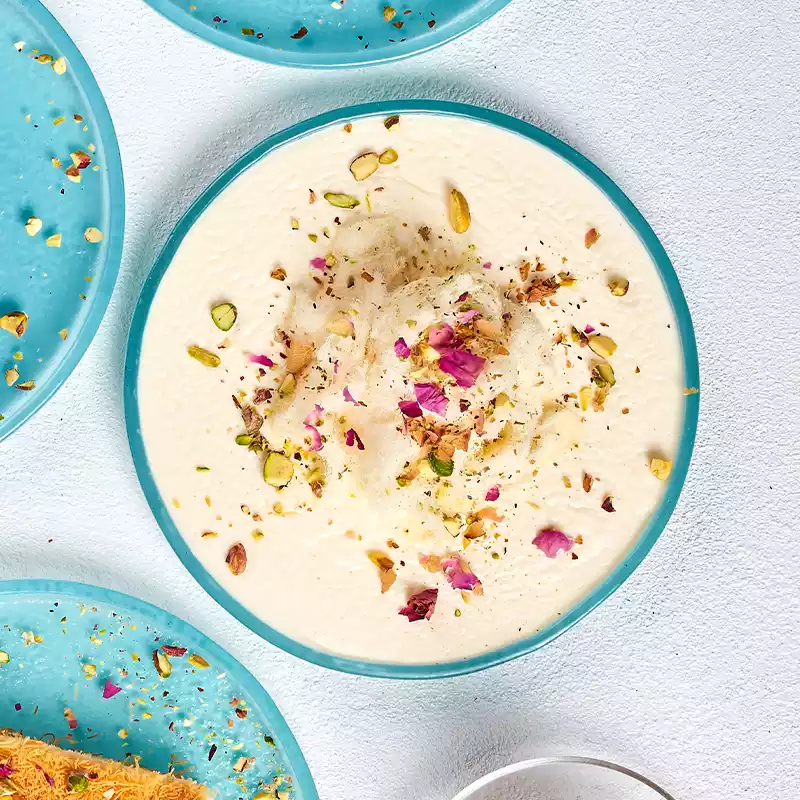
1. An Ancient Legacy:
Mahalabia can trace its roots back to the days of the Arab Empire, where dairy-based desserts were highly valued for their nourishing and cooling properties. The recipe for Mahalabia has evolved over centuries, adapting to regional preferences and incorporating local ingredients. that you will find at Arabian Fish House restaurant
2. The Essence of Simplicity:
One of the beauties of Mahalabia lies in its simplicity. The primary ingredients include milk, sugar, and a thickening agent such as rice flour or cornstarch. Fragrant additions like rose water, orange blossom water, or ground cardamom are often incorporated to infuse the dessert with a subtle floral or aromatic note. The result is a silky-smooth pudding that is both comforting and satisfying.
3. A Tale of Preparation:
Preparing Mahalabia is a straightforward process that requires a gentle touch and patience. The milk is slowly heated, allowing it to infuse with the flavors of the chosen aromatic agent. The thickening agent is then added gradually, while constant stirring ensures a lump-free consistency. Once the mixture thickens, it is poured into serving bowls or a large dish and left to cool and set. Before serving, a sprinkle of ground pistachios, almonds, or a dusting of cinnamon adds a delightful finishing touch.
4. Cultural Significance:
Mahalabia holds cultural significance in Sharjah dessert cuisine and is served on various occasions, from family gatherings to festive celebrations. During the holy month of Ramadan, it is commonly enjoyed as part of the after meal, breaking the day-long fast. Mahalabia’s presence on dessert tables signifies warmth, hospitality, and the sharing of joyous moments.
Knafeh: A Sweet and Cheesy Delight from the Arabic sweets Sharjah dessert
If you have a passion for desserts, then you must acquaint yourself with the delectable treat known as Knafeh. Hailing from the Arabic sweets Sharjah dessert, Knafeh is a mouthwatering dessert that combines a delicate balance of sweet and savory flavors. With its crisp, golden exterior, gooey cheese filling, and aromatic syrup, Knafeh has captured the hearts of dessert enthusiasts worldwide. In this article, we will delve into the origins, ingredients, preparation, and cultural significance of Knafeh, unraveling the secrets behind this beloved Arabic sweet Sharjah dessert
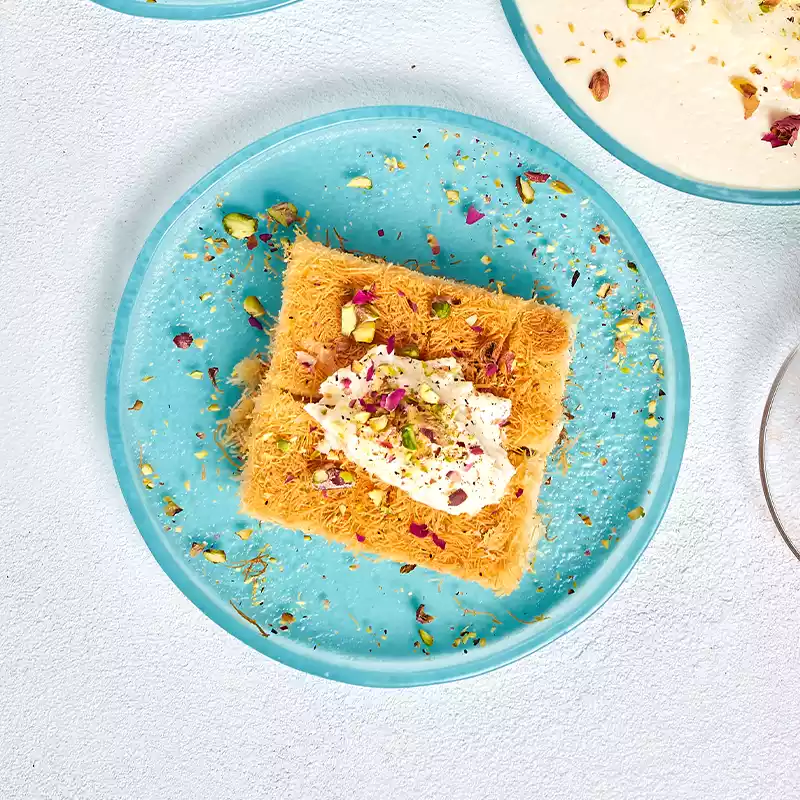
Tracing the Roots:
Knafeh has a rich history that spans centuries. Its origins can be traced back to the Levant region, including countries such as Lebanon, Syria, Palestine, and Jordan. Over time, it has become an iconic dessert across the Arabic sweets Sharjah dessert, with each region adding its own unique twist to the recipe. Today, Knafeh is enjoyed in various forms, each showcasing the culinary traditions of its respective locale.
The Perfect Marriage of Sweet and Savory:
At the heart of Knafeh lies a harmonious combination of sweet and savory flavors. The dessert typically features a layer of shredded phyllo dough or semolina-based pastry known as kataifi, which forms a crispy golden crust when baked or fried. This is then filled with a generous amount of white cheese, traditionally Akkawi or Nabulsi cheese, which melts to create a gooey and creamy interior. The indulgence is taken to another level with the addition of a fragrant sugar syrup infused with rose or orange blossom water, imparting a distinctive Arabic sweets Sharjah dessert aroma.
The Art of Preparation:
Preparing Knafeh requires a skilled hand and attention to detail. The shredded pastry is mixed with melted butter to achieve a golden and crispy texture when baked. The cheese filling is carefully layered on top, ensuring a perfect balance between the sweet and savory components. The dessert is then baked in the oven until the cheese melts and the pastry turns golden and crisp. Once removed from the oven, the fragrant syrup is generously poured over the Knafeh, allowing it to soak in and enhance the flavors.
A Symbol of Celebration:
Knafeh holds significant cultural importance in Arabic sweets Sharjah dessert cuisine and is frequently served on joyous occasions and festive celebrations. It is particularly popular during the holy month of Ramadan and is often enjoyed as part of the after meal, breaking the fast at sunset. The presence of Knafeh on dessert tables signifies hospitality, abundance, and the sharing of happiness among family and friends.
Basbousa: A Scrumptious Semolina Cake from the Arabic sweets Sharjah dessert
If you’re seeking a dessert that combines the comforting flavors of semolina, the sweetness of syrup, and the richness of nuts, look no further than Basbousa. Originating from the Arabic sweets Sharjah dessert, Basbousa is a beloved semolina cake that has won hearts with its moist texture and irresistible taste. Whether enjoyed with a cup of tea or as a dessert after a hearty meal, Basbousa offers a delightful indulgence. In this article, we will explore the origins, ingredients, preparation, and cultural significance of Basbousa, uncovering the secrets behind this mouthwatering Arabic sweets Sharjah dessert delight.
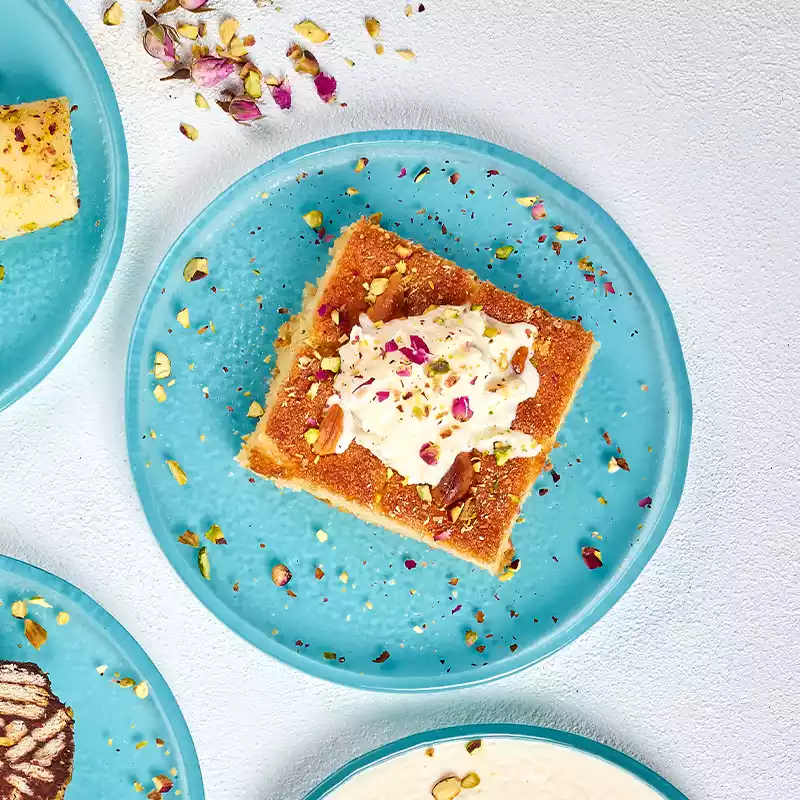
1. A Journey through Time:
Basbousa has a long-standing presence in Arabic sweets and Sharjah dessert cuisine, with roots that can be traced back to the emirate. It has since spread across the region, becoming a popular treat in countries such as Lebanon, Syria, Palestine, and beyond. With variations in preparation and flavors, Basbousa has become a versatile dessert, reflecting the diverse culinary traditions of the Arabic sweets Sharjah dessert. That you will find at Arabian Fish House restaurant
2. The Essence of Semolina:
At the heart of Basbousa lies semolina, a coarse wheat flour that lends the dessert its unique texture. Combined with sugar, butter, and yogurt, the semolina creates a moist and crumbly cake base. The addition of aromatic ingredients like rose water, orange blossom water, or vanilla enhances the flavor, leaving a lingering sweetness on the palate.
3. Nutty Delight and Sweet Syrup:
One of the distinguishing features of Basbousa is its topping of toasted nuts, commonly almonds or pistachios, which add a delightful crunch and visual appeal. The cake is often adorned with a generous drizzle of sweet syrup, typically made from sugar, water, and a splash of lemon juice. This syrup infuses the cake with moisture and sweetness, elevating the overall taste experience.
4. A Simple Pleasure to Prepare:
Basbousa is relatively simple to prepare, making it an accessible dessert for home cooks. The semolina batter is mixed with melted butter, yogurt, sugar, and flavorings, creating a thick and creamy mixture. The batter is then spread into a baking dish, scored into diamond or square shapes, and baked until golden and fragrant. Once removed from the oven, the sweet syrup is poured over the warm cake, allowing it to soak in and infuse every bite with sweetness.
Halawa El Jibin: A Perfect Harmony of Sweetness and Creaminess with Arabic Ice Cream
When it comes to delightful combinations, Halawa El Jibin with Arabic ice cream stands out as a match made in dessert heaven. This Arabic sweets Sharjah dessert treat brings together the rich and nutty flavors of Halawa El Jibin (halva with cheese) with the creamy indulgence of Arabic ice cream. With its contrasting textures and harmonious taste, this dessert duo has won the hearts of dessert enthusiasts across the region and beyond. In this article, we will explore the origins, ingredients, preparation, and irresistible appeal of Halawa El Jibin with Arabic ice cream.

1. A Blend of Traditions:
Halawa El Jibin, also known as halva with cheese, is a traditional Arabic sweet Sharjah dessert sweet made by combining tahini (sesame paste), sugar, and a generous amount of cheese, usually Akkawi or Nabulsi cheese. This unique combination results in a dense and fudgy treat with a rich and nutty flavor. Arabic ice cream, on the other hand, is renowned for its elastic texture, typically achieved by incorporating ingredients like mastic resin or salep powder. By combining these two beloved desserts, a delightful fusion of flavors and textures is born.
2. The Marriage of Sweetness and Creaminess:
Halawa El Jibin provides a sweet and dense foundation for this dessert pairing. The nutty richness of the halva and the creamy saltiness of the cheese create a unique flavor profile that balances sweetness and savory notes. The addition of Arabic ice cream adds a luscious creaminess, complementing the dense halva with its smooth and silky texture. The ice cream may be flavored with classic Arabic sweets Sharjah dessert ingredients like rose water, saffron, or mastic, further enhancing the overall taste experience.
3. Crafting the Perfect Combination:
To create Halawa El Jibin with Arabic ice cream, a slice of Halawa El Jibin is typically warmed slightly to soften its texture. A scoop of Arabic ice cream is then placed on top, allowing it to melt slightly and meld with the halva. The result is a delightful combination of warm and cool, sweet and creamy, creating a sensory experience that tantalizes the taste buds.
4. An Irresistible Indulgence:
Halawa El Jibin with Arabic ice cream is not only a satisfying dessert but also a cultural experience. It is commonly enjoyed during festive occasions, family gatherings, and celebrations. The combination of these two desserts represents a celebration of flavors and a symbol of hospitality, as friends and loved ones come together to share in the joy of indulgence.
Halawa El Jibin with Arabic ice cream is a culinary delight that brings together the best of Arabic sweets Sharjah dessert flavors and textures. The sweet richness of Halawa El Jibin harmonizes with the creamy indulgence of Arabic ice cream, creating a dessert experience that is both comforting and indulgent. Whether enjoyed as a traditional treat or with innovative variations, this dessert duo invites you to savor the unique fusion of tastes and textures. So, take a spoonful of Halawa El Jibin topped with Arabic ice cream and let your taste buds revel in the blissful combination of sweetness and creaminess. That you will find and love at Arabian Fish House Restaurant
Lazy Cake: A Quick and Delicious No-Bake Dessert
When it comes to dessert, sometimes we crave something delicious and satisfying without the hassle of baking. That’s where Lazy Cake comes to the rescue! This no-bake treat is the epitome of simplicity, requiring minimal effort and time while still delivering a delightful and indulgent experience. In this article, we’ll explore the origins, ingredients, preparation, and appeal of Lazy Cake, perfect for those moments when you want a sweet treat without breaking a sweat.
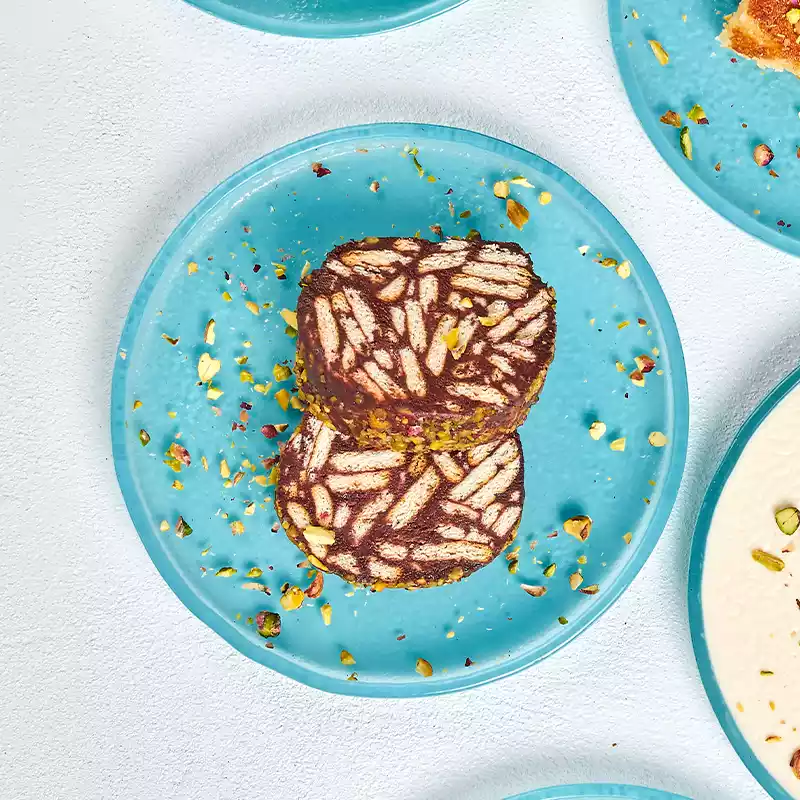
1. The Origins of Lazy Cake:
Lazy Cake, also known as Chocolate Biscuit Cake or Refrigerator Cake, has become a popular dessert worldwide. While its exact origins are unclear, variations of this no-bake cake can be found in different culinary traditions. It offers a convenient solution for satisfying dessert cravings without the need for baking or complicated techniques.
2. Simple Ingredients, Rich Flavor:
One of the charms of Lazy Cake lies in its simplicity. The basic ingredients typically include crushed biscuits, butter, cocoa powder, sweetened condensed milk, and sometimes additional flavorings like vanilla extract or coffee. The combination of these ingredients results in a rich and chocolatey flavor with a soft and fudgy texture.
3. Quick and Effortless Preparation:
Preparing Lazy Cake requires minimal effort and time, making it an ideal dessert for those with busy schedules or limited baking skills. The crushed biscuits are mixed with melted butter, cocoa powder, and sweetened condensed milk until well combined. The mixture is then pressed into a pan or lined mold and chilled in the refrigerator until firm. The cake sets as it chills, allowing the flavors to meld together and the texture to become dense and indulgent.
4. Endless Customization Options:
While the classic version of Lazy Cake is a chocolate lover’s dream, there are numerous ways to customize this dessert to suit your taste preferences. You can add a variety of mix-ins such as chopped nuts, dried fruits, shredded coconut, or even mini marshmallows to add texture and flavor. Additionally, you can experiment with different types of biscuits or cookies to create unique variations. The versatility of Lazy Cake allows for endless creativity and personalization.
5. Perfect for Any Occasion:
Lazy Cake is a versatile dessert that can be enjoyed on various occasions. Whether it’s a casual gathering, a potluck, or a special celebration, Lazy Cake is a crowd-pleaser. It can be served as a standalone dessert or paired with a dollop of whipped cream, a scoop of ice cream, or a drizzle of chocolate sauce for a more decadent presentation. The simplicity and deliciousness of Lazy Cake make it a go-to option when you want to impress your guests with minimal effort.
Zesty Delight: Exploring the Tangy Goodness of Lemon Cake
When it comes to citrus-infused desserts, lemon cake stands out as a zesty delight that captures the essence of freshness and tanginess. With its bright flavor, moist texture, and delicate aroma, lemon cake has become a beloved treat enjoyed by dessert enthusiasts around the world. In this article, we will delve into the origins, ingredients, preparation, and irresistible appeal of lemon cake, celebrating the tangy goodness that makes it a perennial favorite.
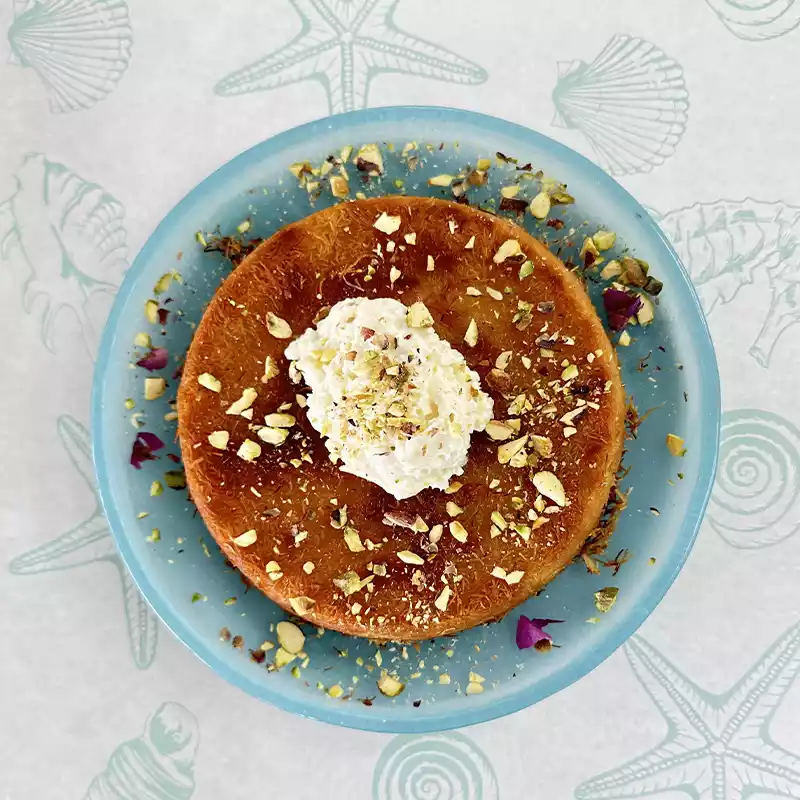
1. A Citrus Classic:
Lemon cake has a rich history dating back centuries, with lemon as the star ingredient. From ancient Mediterranean civilizations to modern-day bakeries, the appeal of lemon’s vibrant flavor and versatility has stood the test of time. The cake’s origins can be traced to various culinary traditions, but its popularity has spread far and wide, transcending cultural boundaries.
2. A Burst of Flavor:
The key to a delectable lemon cake lies in the use of fresh lemons. The tartness and acidity of lemons add a refreshing and vibrant flavor that cuts through the sweetness of the cake. The zest and juice of lemons are often incorporated into the batter, infusing every bite with a burst of citrusy goodness. The balance between the tangy notes and the underlying sweetness creates a harmonious flavor profile.
3. Moist and Tender Texture:
Lemon cake is known for its moist and tender texture, which is achieved through careful ingredient selection and preparation techniques. The addition of ingredients such as buttermilk, yogurt, or sour cream helps to keep the cake moist and tender. The use of oil instead of butter in some recipes also contributes to the cake’s delicate crumb. The result is a light and fluffy cake that practically melts in your mouth.
4. A Versatile Delight:
Lemon cake offers endless possibilities for customization and creativity. It can be enjoyed in various forms, from a simple loaf cake to a layered celebration cake. The addition of lemon zest, lemon curd, or lemon syrup between the layers enhances the lemony flavor and adds a delightful tangy surprise. Lemon glaze or cream cheese frosting can be used to top the cake, adding a touch of sweetness and a visually pleasing finish.
5. A Refreshing Indulgence:
Lemon cake’s bright and refreshing profile makes it a perfect choice for warm weather or as a palate cleanser between heavier meals. Its tangy notes provide a refreshing contrast, making it an appealing dessert during spring and summer gatherings. Whether served as a standalone treat or accompanied by a scoop of vanilla ice cream or a dollop of whipped cream, lemon cake offers a delightful and palate-
Luqaimat: Savoring the Irresistible Sweetness of Sharjah Dessert Delights
In the realm of Sharjah dessert cuisine, Luqaimat stands tall as a beloved indulgence that has been captivating taste buds for centuries. These golden, bite-sized dough balls, often drizzled with a generous amount of date syrup and sprinkled with sesame seeds, offer a delectable blend of sweetness and texture. In this article, we will explore the origins, ingredients, preparation, and irresistible appeal of Luqaimat, a dessert that has become a symbol of Sharjah dessert culinary delight that you will find at Arabian Fish House restaurant and enjoy it
1. A Taste of Tradition:
Luqaimat holds a special place in Sharjah’s dessert culture, particularly during festive occasions and gatherings. With roots in Bedouin traditions, these delectable treats have been passed down through generations, becoming a staple dessert in Sharjah’s dessert cuisine. They are often associated with the holy month of Ramadan, where they are eagerly anticipated and enjoyed as a sweet reward after a day of fasting.
2. Simple Ingredients, Divine Results:
The beauty of Luqaimat lies in its simplicity, both in terms of ingredients and preparation. The dough is made from a basic mixture of flour, yeast, sugar, and water, resulting in a light and airy texture. The dough is then formed into small balls and deep-fried until golden brown, creating a crispy exterior while maintaining a soft and fluffy interior. The magic happens when they are generously drizzled with date syrup, also known as dibs, and sprinkled with sesame seeds, adding a delightful sweetness and nutty flavor.
3. A Symphony of Textures and Flavors:
Luqaimat offers a delightful contrast of textures and flavors. The golden-brown exterior provides a satisfying crunch, while the soft, pillowy interior melts in your mouth. The sweetness of the date syrup complements the slight savory notes of the dough, resulting in a harmonious blend that tantalizes the taste buds. The sesame seeds add a subtle nutty crunch, enhancing the overall sensory experience.
4. A Symbol of Generosity and Hospitality:
Luqaimat holds great cultural significance in Sharjah desert hospitality. It is often served to guests as a gesture of warm welcome and generosity. Sharing a plate of Luqaimat is a cherished tradition that fosters a sense of community and togetherness. During celebratory occasions and family gatherings, these sweet delights create moments of joy and connection, leaving a lasting impression on those who partake in their delectable goodness.
5. Adapting Tradition with a Modern Twist:
While the traditional recipe remains cherished, Luqaimat has also embraced modern variations and creative interpretations. Some chefs experiment with different fillings, such as saffron, cardamom, or cinnamon-infused creams, introducing new layers of flavor to this traditional dessert. Others may explore unique toppings or accompanying sauces, adding a touch of innovation to the timeless treat.
Arabian Fish House
Al Hira Beach-Sharjah
Al Shindagha-Dubai
© 2023 Arabian Fish House. All Rights Reserved.
